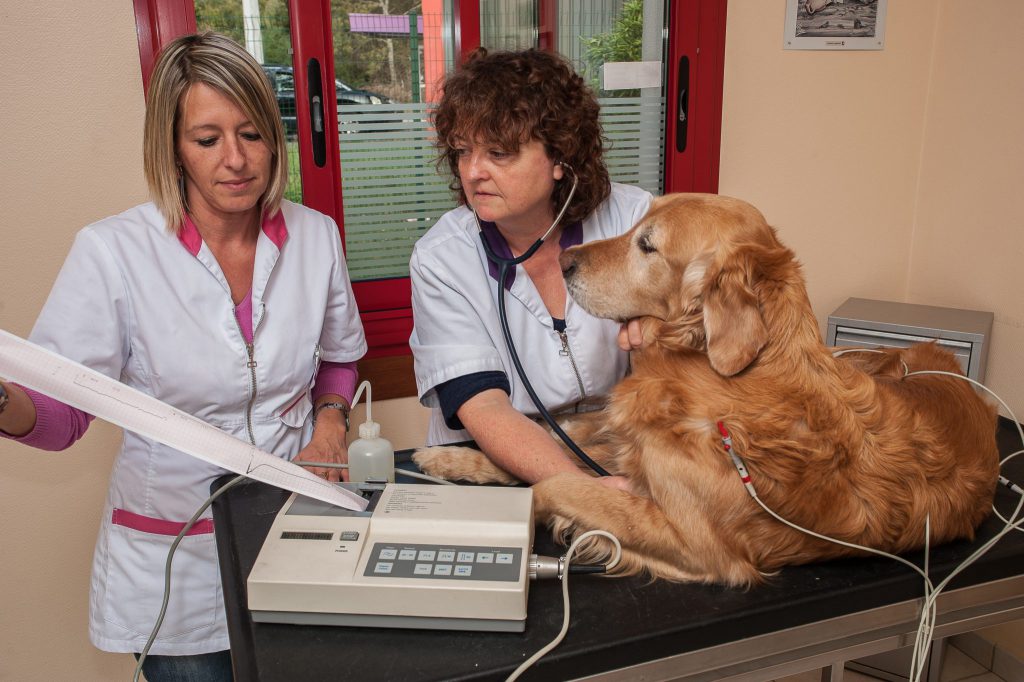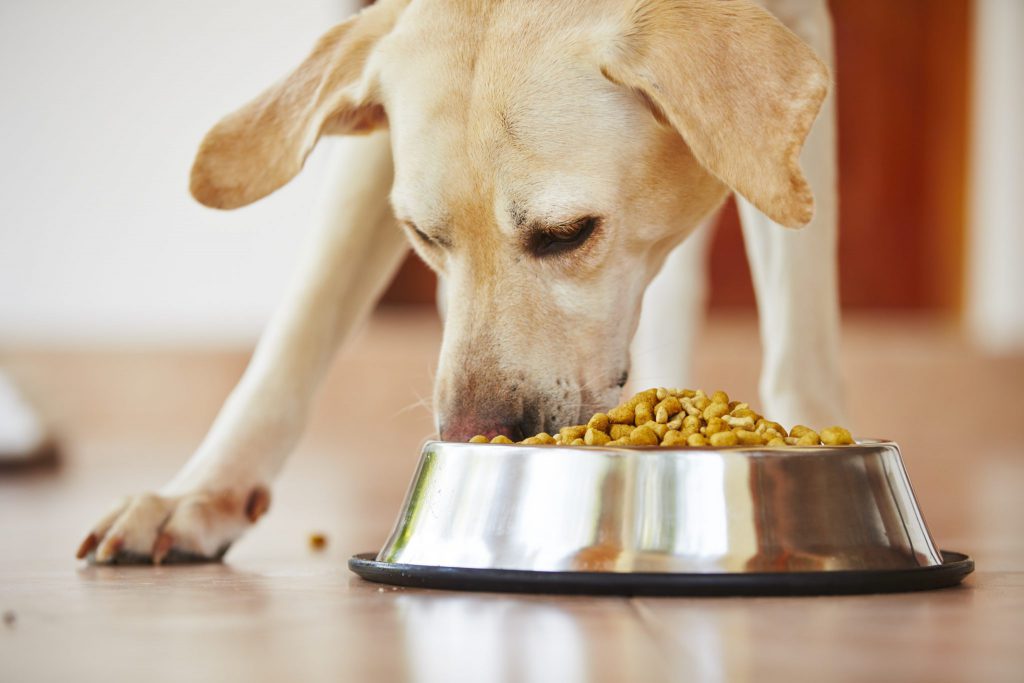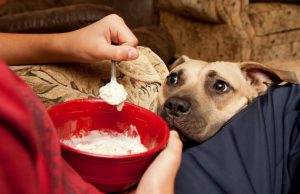That’s right, dog dementia.
Just like humans, aging dogs can become senile, and what starts as a mild condition with a few, almost unnoticeable signs, usually tends to progress and worsen over time. No one likes to think that their dog is getting old, but when your best friend stops responding to its name, stops recognizing you, other family members or friends, and simply start acting different than usual, you’ve got yourself the red flags of dementia or, as it is also called, cognitive dysfunction syndrome.
The usual signs of dementia in dogs are mostly:
In a nutshell, dog dementia is characterized by your dog acting funny and with complete disregard for previously learned training, habits, or house rules, as if it forgot them. Of course, these signs vary from dog to dog and their severity depends on the progression of the condition. It’s not uncommon to see dogs with dementia getting stuck on corners, behind furniture or doors, barking for no reason, or simply becoming slow responding to stimuli or learning new tasks. Other signs may include increased licking due to stress, loss of appetite, decreased self-grooming, and incontinence, urinary or fecal (or even both!).
Plenty of online resources will tell you that about 50% of the dogs older than 11 years will show some sign of dementia, which is a good indicator of how prevalent this issue is.

The cause of dog dementia is unclear. There is evidence pointing to genetic factors, just like Alzheimer’s disease in humans, and we do know by now that there are a few chemical and physical changes occurring in the dog’s body that lead to an increased accumulation of a protein called beta-amyloid in the brain. This protein build-up ultimately slows or blocks nerve transmission and interferes with normal blood circulation in the brain, which, in turn, leads to the changes in awareness and behavior that are the hallmark of dementia. A decrease in dopamine production, a nervous system messenger chemical, may also be involved in the physiopathology of this condition.
There are no specific tests or exams that will tell you that your dog has dementia. Diagnosis is achieved through medical history, a physical examination (particularly focused on cognitive function), and ruling out other diseases, which may include performing blood tests, X-ray or ultrasound exams. Although these will not tell you anything about dementia, they will definitely help to determine no other health issues that may mimic dementia are taking place.

When we talk about treatment, there is a myriad of possibilities and success is achieved by owner compliance and willingness to help his or her dog, as no “magic pill” will do the trick. Many times it takes error and trial to find the right formula that will work for you and your dog.
We can divide treatment into four categories:
Conventional treatment relies on the use of a pharmaceutical drug called anipryl, which aims at reducing the signs of dementia by increasing the concentration of dopamine. The side effects of using anipryl include loss of appetite, increase in water intake, vomiting, anemia, and many owners actually report an increase in the signs of dementia, such as confusion, disorientation, and restlessness.

Changes in lifestyle play a huge role on treating dog dementia. Like any other progressive chronic disorder, life-long therapy and support are essential to maintain a dog’s quality of life. These lifestyle changes include keeping a strict daily routine of feeding, walking, exercising, playing, and training. Maintaining a healthy and stimulating environment is also extremely important and some examples include interacting regularly with your dog, spending time together, taking it out to socialize with other dogs, providing it with stimulating and interactive toys or games, and exercise or training sessions that may be as long as 5 or 10 minutes, depending on the dog’s physical condition, and are helpful to refresh their memory on old tricks. As little as hiding a treat and get it go and find it will contribute to an active lifestyle that will help hindering the progression of dementia. Also, make sure you don’t change the arrangement of the furniture, as it may confuse your dog, and get rid of any clutter you may have lying around because it may trip on it.
Switching to a natural, fresh, raw, unprocessed diet is another step towards health that can help your dog with dementia. You can cook it yourself, as there are so many good resources out there teaching you how, or you can look for commercial options, many of which have companies behind them that are truly concerned with providing more natural dog food options to their clients.

Herbs and supplements are of paramount importance in treating and managing dementia, as so many dog owners share in testimonies after they witness firsthand the improvements brought about by their use. Some herbal treatments and supplements that are recommended include hawthorne, gingko biloba (also known as waterhyssop), bacopa, Gotu Kola, alpha lipid acid, choline, rosemary, vitamin B6, resveratrol, flaxseed oil, coconut oil, turmeric, rhodiola, and omega-3 fatty acids. While some of these herbs and supplements have long been used in Ayurvedic and traditional Chinese medicine, others have started being used more recently, but all of them are known for their anti-aging, anti-inflammatory, and antioxidant properties.
Other holistic alternatives include acupuncture, aromatherapy to manage anxiety, and bioacoustics therapy or, more simply put, music! Yes, research tells us that simple sound, mostly classical music, enhances mind-body states that are conducive to healing and wellness.

We definitely do not need research to tell us how much of an effect music has on our nervous system, so why would it be any different with our pets? Well, it’s not. There are plenty of resources on YouTube that provide hours of relaxation music specific for pets, selected on the grounds of resonance (tone) and entrainment (rhythm), which basically make the breath, brainwaves, and heartbeat slow down to match the music.
Prevention of dementia before any signs appear is possible by switching to a more natural diet, using less chemical flea and tick products, and start supplementing with natural options with anti-inflammatory properties. Remember that natural approaches to disease tend to take more time to show their effectiveness, as they act slower than conventional drugs. All in all, it’s an everyday effort and a commitment to health that you must be up for. In the long run, though, it’s totally worth it.

It is never too late to improve your dog’s health and overall quality of life. As food and diet play a crucial role in our health, so it does for our pets.
Degenerative diseases, obesity, and a decrease in vitality and energy tend to accompany senior dogs as they grow older and are probably the result of lifelong diets that were rich in carbohydrates.

Poor diets, processed foods, bad fats, and bad starches are altogether the root of many conditions that result from an inflammatory state. Inflammation brings about metabolic imbalances that ultimately lead to disease.
Dogs are now aging faster than ever before. While a geriatric dog used to be 12 years old or older, now an 8-year-old dog is considered senior. The reason behind it is closely linked to the appearance of commercial pet foods and its use as first choice to feed pets all over the world. While easy to use, affordable, and supposedly complete in terms of pet nutrition, dry kibble, the most common commercial pet food available, is not real food.
Dry kibble is processed food made from meat by-products that are rejected in meat-processing facilities – any and every part of an animal carcass that is not appropriate for human consumption.

So, with so many different and controversial information coming from everywhere, how do we know which is best for our senior pet and what to feed him so that he has a healthy life? Well, thinking about what is the closest to nature and to the animal’s natural state is a good start. Biologically-appropriate raw food, or BARF, is a type of diet that mimics the feeding regime of a wild or feral animal and is based on whole raw foodstuffs. It is the diet dogs have evolved to eat.
Because dogs are, in nature, hunters and scavengers, but also omnivores, both animal and plant-derived raw foods are appropriate.
A raw food diet is composed of meat, bones, organs (usually liver or kidney), eggs, and vegetables. Meat should comprise at least 60% of the diet (with organs making up 2.5% of the meat quantity) and vegetables the remaining 40%. One egg a day (also raw) and a fish oil supplement to provide the omega-3 fatty acids your dog needs will make the diet complete.

Other supplements may be needed, depending on your dog’s health status. Glucosamine-type supplements are beneficial for senior dogs with arthritis or joint problems.
Not all vegetables are good for your dog. Green, leafy, non-starchy vegetables are the best, as your dog as no nutritional need for carbohydrates.
Nutritional choices are relative when it comes to choosing the right vegetables to feed your senior dog, especially if he has pre-existing health conditions. So, for example, dogs with diabetes should be fed vegetables that have a low glycemic index – green beans are a great choice!

For dogs with cancer we should focus on those with the least sugar and the most anti-oxidants, such as kale or broccoli.
Also, vegetables should be lightly steamed or blended to mimic the natural predigestion that would take place in nature, as dogs would eat a prey that had previously ingested vegetables. Warm food is best for the same reasons, as it mimics a freshly killed prey.
But what about the switch? How do we make the switch from processed, commercial pet food to a fresh raw diet? Most dogs will find the new food much more appealing and delicious so, in most cases, simply switching to a raw diet with no transition period will work wonders!

However, if your dog is more sensitive or already has dental problems that may make it difficult to chew bones or vegetables, you can always adapt. The latter can be solved by mixing and grinding all ingredients together to make eating a little easier.
The former can be dealt with a more careful approach, by making a gradual transition and starting by adding probiotics to prevent diarrhea. A few days after starting with the probiotics, slowly start introducing the meat and then the vegetables.
Pay special attention to the fact that dry kibble and raw food should not be mixed as that may cause imbalances.
Consider the time and budget you have available and be ready to spend a couple of hours each week preparing and portioning your dog’s food, which can then be frozen and thawed as needed.

As time goes by and you learn more about your dog’s preferences and needs, as well as adjusting the proportions and quantities to meet your dog’s dietary requirements, the task will become easier and simpler.
Always use stainless steel bowls, as plastic bowls may harbor pathogens and are suitable environments for their growth.
You should also remember that some dogs may take some time to adapt to the new diet, as they may be too addicted to the carbohydrates from their previous foods, as well as salt. Give him some time to adjust to the new textures and flavors and your dog will never want to go back to the old habits.
Hip & Joint Supplement
[/et_pb_text][et_pb_image src="https://vetnaturals.com/wp-content/uploads/2017/04/amazon-btn-150.png" url="https://www.amazon.com/Veterinary-Naturals-Hemp-Hips-Inflammation/dp/B01N2S774K/ref=lp_16740413011_1_1?srs=16740413011&ie=UTF8&qid=1506810789&sr=8-1" _builder_version="3.0.72" show_bottom_space="on"]
Hip & Joint Supplement
[/et_pb_text][et_pb_image src="https://vetnaturals.com/wp-content/uploads/2017/04/chewy-btn-150.png" url="https://www.chewy.com/veterinary-naturals-hemp-hips/dp/152766" _builder_version="3.0.72" show_bottom_space="on"]
Probiotic with Skin & Coat Supplement
[/et_pb_text][et_pb_image src="https://vetnaturals.com/wp-content/uploads/2017/04/amazon-btn-150.png" url="https://www.amazon.com/Veterinary-Naturals-Health-Probiotic-Supplement/dp/B06XTBV8SX/ref=lp_16740413011_1_3?srs=16740413011&ie=UTF8&qid=1506811161&sr=8-3" _builder_version="3.0.72" show_bottom_space="on"]
Probiotic
[/et_pb_text][et_pb_image src="https://vetnaturals.com/wp-content/uploads/2017/04/chewy-btn-150.png" url="https://www.chewy.com/veterinary-naturals-hemp-health/dp/152768" _builder_version="3.0.72" show_bottom_space="on"]
[et_pb_section fb_built="1" admin_label="section" _builder_version="3.0.47"][et_pb_row admin_label="row" _builder_version="3.0.47" background_size="initial" background_position="top_left" background_repeat="repeat"][et_pb_column type="4_4" _builder_version="3.0.47" parallax="off" parallax_method="on"][et_pb_text _builder_version="3.0.47" background_size="initial" background_position="top_left" background_repeat="repeat"][/et_pb_text][et_pb_text _builder_version="3.0.47" background_size="initial" background_position="top_left" background_repeat="repeat"]
Fatty acids are an important component of a dog’s diet, as they are necessary for maintaining good health and preventing disease. Fatty acids are the most important supplement you can give to your dog, regardless of what type of diet it eats.
The fatty acids that are particularly relevant are omega-3 fatty acids. EPA (eicosapentaenoic acid) and DHA (docosahexaenoic acid) are the most important and they must be supplied directly from food, as dogs (and humans too), cannot produce them
[/et_pb_text][et_pb_image src="https://vetnaturals.com/wp-content/uploads/2017/07/photo3.jpg" align="center" _builder_version="3.0.47" animation_style="slide" animation_direction="left" animation_duration="500ms" animation_intensity_slide="10%"][/et_pb_image][et_pb_text _builder_version="3.0.47" background_size="initial" background_position="top_left" background_repeat="repeat"]
Besides omega-3, omega-6 fatty acids are also an important requirement for dogs, but because they are widely available in today’s dog diets, especially in commercial pet food, we don’t hear about them as often. In fact, omega-6 fatty acids are plentiful in any diet, so it is important to provide enough omega-3 fatty acids in order to maintain an adequate omega-6:omega-3 ratio. This ratio should be low (4:1 or 3:1) and supplementing with omega-3 will compensate potential imbalances created by feeding a diet with high contents of omega-6 (and thus a high omega-6:omega-3 ratio). Also, EPA and DHA are fragile compounds that do not survive storage conditions or the processing of kibble, thus the need to supplement.
Both fish and plant oils are important sources of fatty acids, complementing each other in terms of benefits. Fish oil comes from oily fish, such as salmon or sardines, and it is the result of these fish accumulating omega-3 fatty acids by eating other fish. Plant oils that are commonly used are extracted from different plants, with flaxseeds, coconut, and hempseeds being some examples.
[/et_pb_text][et_pb_image src="https://vetnaturals.com/wp-content/uploads/2017/07/photo1.jpeg" align="center" _builder_version="3.0.47" animation_style="slide" animation_direction="left" animation_duration="500ms" animation_intensity_slide="10%"][/et_pb_image][et_pb_text _builder_version="3.0.47" background_size="initial" background_position="top_left" background_repeat="repeat"]
While salmon oil is a source of readily available omega-3 fatty acids, hempseed oil is rich in alpha-linolenic acid (ALA), which is a short-chain omega-3 fatty acid that dogs need to convert into EPA and then DHA. As for its benefits though, hempseed oil has the perfect balance of omega 3:omega 6 fatty acids, along with other benefits recognized by the traditional Chinese medicine long ago.
Hempseed oil has health-promoting and healing properties and it is a powerful anti-oxidant that relieves inflammation. It is easily digested and is a rich source of amino acids.
With so many great properties, salmon and hemp oil makes the perfect combination of a fatty acid supplement. But what are, after all, the 5 benefits of using salmon and hemp oil?
[/et_pb_text][et_pb_text _builder_version="3.0.47" background_size="initial" background_position="top_left" background_repeat="repeat"]
1. Improves skin and coat
Fatty acids play an important role in reducing inflammation, which benefits different organs and systems. The skin and coat are no exception. Their health and overall looks improve when adding fatty acids to a dog’s diet. Scientific studies have provided evidence that fatty acid supplementation reduces itching, self-trauma, hair loss, and helps maintaining a healthy coat. There is also evidence that fatty acid supplementation alleviates the symptoms of a dermatologic condition called atopic dermatitis.
[/et_pb_text][et_pb_image src="https://vetnaturals.com/wp-content/uploads/2017/07/photo2.jpg" align="center" _builder_version="3.0.47" animation_style="slide" animation_direction="left" animation_duration="500ms" animation_intensity_slide="10%"][/et_pb_image][et_pb_text _builder_version="3.0.47" background_size="initial" background_position="top_left" background_repeat="repeat"]
2. Helps cognitive function
Fatty acids are known promoters of cognitive function and neurologic health. They help in the development of fetuses and puppies, and stimulate brain function, aiding in the prevention of dog dementia. Clinical trials comparing groups of animals with and without fatty acid supplementation have shown great improvements in behavioral attributes, agility, recognition of family and other animals (symptoms associated with dog dementia), as well as a decrease in excessive licking and pacing in dogs taking the supplements.
3. Reduces inflammation
Because fatty acids reduce inflammation, any condition resulting from it will improve. Arthritis, allergies, and inflammatory bowel disease are good examples of health issues that improve with fatty acid use. Any chronic and degenerative disease for which inflammation is the root cause will see its symptoms decrease due to the anti-inflammatory properties of EPA and DHA.
[/et_pb_text][et_pb_image src="https://vetnaturals.com/wp-content/uploads/2017/07/photo4.jpeg" align="center" _builder_version="3.0.47" animation_style="slide" animation_direction="left" animation_duration="500ms" animation_intensity_slide="10%"][/et_pb_image][et_pb_text _builder_version="3.0.47" background_size="initial" background_position="top_left" background_repeat="repeat"][/et_pb_text][et_pb_text _builder_version="3.0.47" background_size="initial" background_position="top_left" background_repeat="repeat"]
4. Regulates the immune system
Essential fatty acids boost the immune system, whenever it is suppressed, but they also calm it down when it is overreactive (as in allergies or autoimmune disease), thus acting as a regulator of the immune system. Any condition that is directly related to the immune function will therefore benefit from fatty acid uptake.
5. Helps preventing cancer
Salmon and hemp oil are also a good option as an adjuvant to prevent and treat cancer. Essential fatty acids promote apoptosis, or programmed cell death, of cancerous cells via a mechanism of lipid peroxidation. On doing so, they reduce the tumor burden and help reducing tumor growth. Scientific evidence supports the beneficial effects of fish oil on different types of cancer, including breast, prostate, and colon cancer in humans. Why would it be different in dogs?
As if these were not enough reasons to start supplementing your dog with fatty acids, there is evidence that fish oil also helps in cardiovascular and renal disorders, lowers blood pressure and triglycerides, and promotes weight loss in overweight dogs. It’s all benefits.
[/et_pb_text][et_pb_text _builder_version="3.0.47" background_size="initial" background_position="top_left" background_repeat="repeat"]
You can buy our vet prescribed supplement here :
Hemp & Hips
[/et_pb_text][et_pb_image src="https://vetnaturals.com/wp-content/uploads/2017/04/amazon-btn-150.png" url="https://www.amazon.com/dp/B06ZYSPJF6" url_new_window="on" _builder_version="3.0.47" animation_style="slide" animation_direction="left" animation_duration="500ms" animation_intensity_slide="10%" saved_tabs="all"][/et_pb_image][et_pb_text _builder_version="3.0.47" background_size="initial" background_position="top_left" background_repeat="repeat"]
The most natural source of omega fatty acids for your dog you're not using:
Salmon & Hemp Oil
[/et_pb_text][et_pb_image src="https://vetnaturals.com/wp-content/uploads/2017/04/amazon-btn-150.png" url="https://www.amazon.com/dp/B0727KT379" url_new_window="on" _builder_version="3.0.47" animation_style="slide" animation_direction="left" animation_duration="500ms" animation_intensity_slide="10%" saved_tabs="all"][/et_pb_image][/et_pb_column][/et_pb_row][/et_pb_section]
[et_pb_section fb_built="1" admin_label="section" _builder_version="3.0.47"][et_pb_row admin_label="row" _builder_version="3.0.47" background_size="initial" background_position="top_left" background_repeat="repeat" custom_padding="27px|0px|0px|0px"][et_pb_column type="4_4" _builder_version="3.0.47" parallax="off" parallax_method="on"][et_pb_text _builder_version="3.0.47" background_size="initial" background_position="top_left" background_repeat="repeat"]
 Unfortunately, our pets are just like their parents when it comes to diet and nutrition. Our dogs are what they eat. A diet with excessive calories, manufactured dog food with fillers and too many table scraps can slow them down. If your dog is overweight, the extra pounds will place a burden on his or her hips, joints and bones. Easing your dog onto a lower calorie diet is a first step in helping your dog reduce his or her weight. Most dog food companies even have special blends for senior and less active dogs. They help lower the daily calorie intake for your dog, while making sure your dog has the proper nutrition. The hard part, no matter how much they beg or make puppy eyes at the table, is to greatly reduce the food that goes from your plate into their mouths. While we think we’re showing our love for our dogs by sharing our food and leftovers, we’re usually just adding extra calories and pounds to their frame. In our house, our dogs found it devastating when we didn’t feed them from the table. After nights of aggressive whining, begging and a lot of paws on our legs during dinner, we came up with a trick. Instead of giving our dogs human food from the table, we just handed them a small piece of their kibble. While this trick seems as cruel as handing out apples at Halloween, it started to reverse the trend of them gaining weight.
Unfortunately, our pets are just like their parents when it comes to diet and nutrition. Our dogs are what they eat. A diet with excessive calories, manufactured dog food with fillers and too many table scraps can slow them down. If your dog is overweight, the extra pounds will place a burden on his or her hips, joints and bones. Easing your dog onto a lower calorie diet is a first step in helping your dog reduce his or her weight. Most dog food companies even have special blends for senior and less active dogs. They help lower the daily calorie intake for your dog, while making sure your dog has the proper nutrition. The hard part, no matter how much they beg or make puppy eyes at the table, is to greatly reduce the food that goes from your plate into their mouths. While we think we’re showing our love for our dogs by sharing our food and leftovers, we’re usually just adding extra calories and pounds to their frame. In our house, our dogs found it devastating when we didn’t feed them from the table. After nights of aggressive whining, begging and a lot of paws on our legs during dinner, we came up with a trick. Instead of giving our dogs human food from the table, we just handed them a small piece of their kibble. While this trick seems as cruel as handing out apples at Halloween, it started to reverse the trend of them gaining weight.
Whatever excuse we have for not going to the gym today, our pets depend on us for a good workout. A moderate amount of daily exercise helps dogs maintain a healthy weight and mobility. Whether it’s a leisurely walk, tossing a ball around or just fun interactive play-time, the movement and mobility often helps with the onset of arthritis. Our pets love interacting with us, as much as we love spending time with them. Finding some time to be active together has the benefit of helping us and our dogs!
 No. We’re not suggesting your dog head to the nearest spa for a facial, massage and a mud bath (they just might like that!). Some pet physical therapists have noted how hot tubs, controlled swimming, and whirlpools are great for pets with arthritis. Short periods of increased warmth, interspersed with cold, can help reduce your pet’s aches and pains. Having your dog in the water also makes them lighter, so there is less pressure on their joints and bones. There are therapists who specialize in dog massages for arthritic dogs. You can look online for a local dog physical therapist or ask for recommendations from your vet.
No. We’re not suggesting your dog head to the nearest spa for a facial, massage and a mud bath (they just might like that!). Some pet physical therapists have noted how hot tubs, controlled swimming, and whirlpools are great for pets with arthritis. Short periods of increased warmth, interspersed with cold, can help reduce your pet’s aches and pains. Having your dog in the water also makes them lighter, so there is less pressure on their joints and bones. There are therapists who specialize in dog massages for arthritic dogs. You can look online for a local dog physical therapist or ask for recommendations from your vet.
 Without thinking about it, our homes might be an uncomfortable place for a dog with reduced mobility, the onset of arthritis or hip dysplasia. However, it’s very easy to make some minor adjustments to help our dogs. When a dog has even the early signs of arthritis, our pets don’t have the balance, strength, an
Without thinking about it, our homes might be an uncomfortable place for a dog with reduced mobility, the onset of arthritis or hip dysplasia. However, it’s very easy to make some minor adjustments to help our dogs. When a dog has even the early signs of arthritis, our pets don’t have the balance, strength, an
d coordination they once did. Ensuring the doormats, rugs and other loose surfaces are secure will a big help from slipping and falling. It might also be time to take another look at your dog’s bed. Older and arthritic dogs will prefer and benefit from a warm, cozy and comfy bed. A few extra blankets in her bed can give your dog a lot of extra comfort and relief. When your dog was younger, he or she used to love to jump in the car and sofa. Now that your dog is beginning to slow down a bit, there are ways to help here too. Ramps that add a gentle slope into the car or onto furniture bring a lot of relief to your dog. There are a number of retailers who carry products that will have a readymade ramp for your dog. You will want to ensure that they are stable, secure and have a slope your dog can handle. Of course, you can still pick up and carry your dog. See item number 1 on the list…
There are a number of dog supplements that might help provide relief, comfort, and support to your dog. Finding a supplement that helps increase mobility, reduces inflammation and pain is key. Your veterinarian is the best person to talk to, in order to ensure you find the right supplement.
He or she will probably advise you to find a supplement with Glucosamine, Chondroitin, MSM as the basic active ingredients, as a place to start. There are also a lot of holistic ingredients you might want to consider for your dog. Turmeric, for example, is a natural remedy that provides a lot anti-inflammatory properties. Fish oils are another great ingredient that acts as an anti-inflammatory. Lastly, hemp oil, is one of nature’s more powerful anti-inflammatories. You can read our other blog for more information on hemp.
[/et_pb_text][et_pb_text _builder_version="3.0.47" background_size="initial" background_position="top_left" background_repeat="repeat"]You can buy our vet prescribed supplement here :
[/et_pb_text][et_pb_image src="https://vetnaturals.com/wp-content/uploads/2017/04/amazon-btn-150.png" url="https://www.amazon.com/dp/B06ZYSPJF6" url_new_window="on" _builder_version="3.0.47" animation_style="slide" animation_direction="left" animation_duration="500ms" animation_intensity_slide="10%" saved_tabs="all"][/et_pb_image][et_pb_image _builder_version="3.0.47" animation_style="slide" animation_direction="left" animation_duration="500ms" animation_intensity_slide="10%"][/et_pb_image][et_pb_image _builder_version="3.0.47" animation_style="slide" animation_direction="left" animation_duration="500ms" animation_intensity_slide="10%"][/et_pb_image][/et_pb_column][/et_pb_row][/et_pb_section]
[et_pb_section fb_built="1" admin_label="section" _builder_version="3.0.47" custom_padding="54px|0px|0px|0px"][et_pb_row admin_label="row" _builder_version="3.0.47" background_size="initial" background_position="top_left" background_repeat="repeat"][et_pb_column type="4_4" _builder_version="3.0.47" parallax="off" parallax_method="on"][et_pb_text admin_label="Text" _builder_version="3.0.47" background_size="initial" background_position="top_left" background_repeat="repeat"]
As dogs grow older, their needs may change. A healthy, balanced diet and appropriate exercise are essentialto keep up with their changing needs and provide them with the quality of life they deserve. But what is a senior dog, after all?
Seniority in dogs depends on their life expectancy, which is associated with their size and breed. Giant dog breeds are considered to reach seniority at around 6 years old, as their life expectancy usually does not go beyond 8 or 9 years. Smaller dog breeds, on the other hand, reach old age later. A senior Poodle, for example, would be considered a senior dog at around 14 or 15 years old.
Older dogs are usually less active and have a slower metabolism, which makes them less efficient when metabolizing the food they eat. That is why many senior dogs tend to put on weight and some even become obese. However, many other dogs maintain their vitality and good shape during their last years. If a dog’s weight and body condition are good, there is no reason to change a diet that is working well.
[/et_pb_text][et_pb_image src="https://vetnaturals.com/wp-content/uploads/2017/06/pic4.png" align="center" _builder_version="3.0.47" animation_style="slide" animation_direction="left" animation_duration="500ms" animation_intensity_slide="10%"][/et_pb_image][et_pb_text admin_label="Text" _builder_version="3.0.47" background_size="initial" background_position="top_left" background_repeat="repeat"]
When health issues arise, though, the diet should be adjusted to account for the imbalances that are taking place, thus helping to halt the progression of the disease. Dogs with kidney problems should have diets with lower protein content and proteins should be highly digestible; dogs with heart disease should have reduced sodium content in their diets; dogs with constipation problems should have diets with 3 to 5% more fiber; and dogs with cognitive impairment or dementia should take supplements, such as fish oil.
A good diet should be aimed for at any stage of a dog’s life, as it is one of the most important factors determining their health status. That is no different in a senior dog. A proper diet for a senior dog should have good quality protein from an animal source, and not a plant source, and its content should be high, as protein helps maintaining muscle tone, wound healing, supporting the immune and nervous system, and keeping a healthy skin and coat. A common misconception is that older dogs should be on diets with lower protein content, as they help protect kidney and liver function. This is false. Lack of protein may lead to higher susceptibility to stress and muscle wasting, as the body will start using its own muscle to compensate for the protein deficiency. In fact, because older dogs may have trouble metabolizing nutrients, including protein, its content should be high, to make sure they get enough of it.
[/et_pb_text][et_pb_image src="https://vetnaturals.com/wp-content/uploads/2017/06/pic1-1.jpg" align="center" _builder_version="3.0.47" animation_style="slide" animation_direction="left" animation_duration="500ms" animation_intensity_slide="10%"][/et_pb_image][et_pb_text admin_label="Text" _builder_version="3.0.47" background_size="initial" background_position="top_left" background_repeat="repeat"]Carbohydrates are not needed in a dog’s diet. Period. Be it a puppy, an adult dog, or a senior dog, carbohydrates will lead to inflammation, obesity, and maldigestion. Because an older dog may have more trouble metabolizing carbohydrates than a younger dog, the consequences of their consumption are more evident. Inflammation increases arthritis and all types of degenerative diseases, such as cognitive dysfunction (or dementia). Therefore, owners should always aim for a diet with no carbohydrates (excluding fiber, which are indigestible carbohydrates that are beneficial for digestive health).
[/et_pb_text][et_pb_image src="https://vetnaturals.com/wp-content/uploads/2017/06/pic3.jpeg" align="center" _builder_version="3.0.47" animation_style="slide" animation_direction="left" animation_duration="500ms" animation_intensity_slide="10%"][/et_pb_image][et_pb_text admin_label="Text" _builder_version="3.0.47" background_size="initial" background_position="top_left" background_repeat="repeat"]
Excess weight in senior dogs should be controlled by feeding the dog less food and limiting the fat content of his or her diet. However, diets with a low content of fat will leave the dog feeling hungry all the time, which will affect his quality of life. Moreover, fats are needed to keep their skin and coat looking great, they strengthen the immune system, and they play a paramount role in transporting fat-soluble vitamins (vitamins A, D, E, and K). So, when trying to reduce fat content, owners should look for moderately reduced fat content (10 to 14% for dry foods), and not low.
Supplements are also a key component of a senior dog’s dietary plan. They have huge benefits, aiding in the control of specific conditions, but also in the general support of the immune system, which in turn strengthens the dog’s overall ability to fight off disease. Glucosamine and chondroitin are proved to contribute to the health of joints and halt the progression of arthritis; fish oil helps supporting brain function and also healthy joints; turmeric has anti-inflammatory properties that help preventing degenerative disease; anti-oxidants, such as CoQ10, alpha-lipoic acid, vitamins C, E, and A, beta-carotene, and selenium all have beneficial roles in the aging systems of a senior dog, particularly the brain and heart.
[/et_pb_text][et_pb_image src="https://vetnaturals.com/wp-content/uploads/2017/06/pic2.jpg" align="center" _builder_version="3.0.47" animation_style="slide" animation_direction="left" animation_duration="500ms" animation_intensity_slide="10%"][/et_pb_image][et_pb_text admin_label="Text" _builder_version="3.0.47" background_size="initial" background_position="top_left" background_repeat="repeat"]
All things considered, old dogs are just like any other dog. Good quality food, exercise, adapted to his or her specific needs and health status, correct body weight, supplementation, good veterinary care, and lots of love are what make up a healthy, happy dog.
If you’re looking for a supplement to support your senior dog’s hips, joint, digestion, skin & coat or overall better health, check out Veterinary Naturals line of natural, organic and hemp based supplements.
You can find our Probiotic-supplement here :
[/et_pb_text][et_pb_image src="https://vetnaturals.com/wp-content/uploads/2017/04/chewy-btn-150.png" url="https://www.chewy.com/veterinary-naturals-hemp-health/dp/152768" url_new_window="on" _builder_version="3.0.47" animation_style="slide" animation_direction="left" animation_duration="500ms" animation_intensity_slide="10%" custom_css_main_element="float:left;||margin-right:30px;"][/et_pb_image][et_pb_image src="https://vetnaturals.com/wp-content/uploads/2017/04/amazon-btn-150.png" url="https://www.amazon.com/Veterinary-Naturals-Health-Probiotic-Supplement/dp/B06XTBV8SX/ref=pd_sim_199_2?_encoding=UTF8&psc=1&refRID=3YR5M95DHGB1VS2PZM6K" url_new_window="on" _builder_version="3.0.69" animation_style="slide" animation_direction="left" animation_duration="500ms" animation_intensity_slide="10%"][/et_pb_image][et_pb_text admin_label="Text" _builder_version="3.0.47" background_size="initial" background_position="top_left" background_repeat="repeat"]These supplements are designed with the older dog in mind:
[/et_pb_text][et_pb_image src="https://vetnaturals.com/wp-content/uploads/2017/04/amazon-btn-150.png" url="https://www.amazon.com/dp/B06ZYSPJF6" url_new_window="on" _builder_version="3.0.47" animation_style="slide" animation_direction="left" animation_duration="500ms" animation_intensity_slide="10%"][/et_pb_image][et_pb_image _builder_version="3.0.47" animation_style="slide" animation_direction="left" animation_duration="500ms" animation_intensity_slide="10%"][/et_pb_image][/et_pb_column][/et_pb_row][/et_pb_section]
[et_pb_section bb_built="1" admin_label="section" _builder_version="3.0.47"][et_pb_row admin_label="row" _builder_version="3.0.47" background_size="initial" background_position="top_left" background_repeat="repeat"][et_pb_column type="4_4"][et_pb_text _builder_version="3.0.47" background_size="initial" background_position="top_left" background_repeat="repeat" use_border_color="off" border_color="#ffffff" border_style="solid"]
Eventually, every dog will develop arthritis. As dogs get old, their cartilage wears out and becomes weaker. The synovial fluid, the fluid that lubricates the joints, reducing friction and absorbing shock during movement, becomes less abundant. The ability for cartilage to heal decreases and the propensity for breaking down increases.
With all this going on, the ends of bones, both in the front and hind legs, come into direct contact and start grinding against each other. Without the protective action of the fully functional cartilage, joints become swollen and painful. Dogs will show signs of lameness and limb stiffness, they will be reluctant to move, use stairs, or simply getting up and lying down.
Arthritis means inflammation of the joints and the term is used to describe a whole range of joint issues, including hip dysplasia, osteochondritis, and different spinal problems.
The type of arthritis usually seen in senior dogs is degenerative joint disease, which may occur concurrently with other types of arthritis, such as hip dysplasia. Every old dog has at least some degree of arthritis, as it reflects the natural aging process, backed up by lifelong processed diets, sometimes lacking nutrients that are essential for maintaining joint health.
But it is possible to control arthritis and even reverse some of its clinical signs by reducing the inflammation and pain, and thus improving your dog’s quality of life.
Conventional treatment includes the use of non-steroid anti-inflammatory drugs (NSAIDs), which reduce inflammation but also have adverse effects, especially gastro-intestinal, and should be used only in extreme cases. Polysulfated glycosaminoglycan (PSGAG) is also commonly used for promoting cartilage growth and repairing cartilage damage.
Controlled exercise to keep the joints moving is paramount and physical therapy and massages also play important roles in the treatment of arthritis. They help supporting the muscles and improve overall circulation.
Hydrotherapy is one of the best types of physical therapy you can give your dog, as the water supports the dog’s weight, increasing the range of joint movement, at the same time it helps muscles to relax, due to the warmth of the water, and strengthen, by providing resistance.
Weight control is another crucial component for treating arthritis, as many scientific studies have proven that weight reduction lead to a substantial improvement in clinical lameness secondary to osteoarthritis.
Along with weight loss, a pleasant and comfortable environment help your dog feel safe and at ease.
Supplementation is a natural way to help your arthritic dog, with proven results and virtually no secondary effects.
Glucosamine is a known nutritional supplement that helps in the production of lubricating fluid and reduces free radicals that damage the cartilage. Herbal supplements have also been proven effective in decreasing inflammation. Alfalfa (Medicago sativa) and turmeric are good examples with excellent results.
At last, homeopathy is a good resource with many different options that include the use of Rhus toxicodendrum 6c, Brygonia 6c, Belladonna 6c, Nux vomica 6c, and Pulsatilla 6c. These are plants that are approved for homeopathic use, with 6c standing for a small dilution that is more adequate to treat chronic conditions, such as arthritis.
As you can see, options abound. Going towards a more natural treatment is always preferable.
Using supplements for helping with the inflammation, even as prevention, coupled with physical therapy and moderate exercise are great ways to improve your dog’s mobility when reaching seniority.
A natural diet comprised of fresh food, as opposed to processed pet food, with little or no meat and dairy, is also an interesting alternative, as it leads to a reduction in inflammation and therefore helps in pain management.
It’s up to you to try and see what best fits you and your dog as to give it the best life possible.
[/et_pb_text][/et_pb_column][/et_pb_row][/et_pb_section]
[et_pb_section bb_built="1" admin_label="section" _builder_version="3.0.47"][et_pb_row admin_label="row" _builder_version="3.0.47" background_size="initial" background_position="top_left" background_repeat="repeat"][et_pb_column type="4_4"][et_pb_text _builder_version="3.0.47" background_size="initial" background_position="top_left" background_repeat="repeat" custom_css_main_element="||"]
We have all probably heard of probiotics before, especially in yogurt ads, and the wonders of including them in our diet. But what are probiotics and why do our dogs need them as much as we do?
Probiotics are live microorganisms that are directly fed in certain amounts to benefit the health of the host, be it a human or a dog. These microorganisms are naturally found in the gut and are essential for keeping good health. The word probiotics come from the Latin word “pro”, that means for and the Greek word “bios”, that means life – so the word probiotics itself tells us they are beneficial, or for life!
It has long been known that the gut is the largest immune organ in the body, where most of the immune cells are present. Furthermore, there is a primordial connection between the gut and the brain – the intestinal flora is responsible for producing neurotransmitters and neurochemicals that are essential for the production of certain hormones in the brain, like serotonin, the well-known hormone of happiness. The brain is aware of the intestinal microbiota, which in turn affects behavior and the way the world is perceived by animals – humans and dogs included!

Having in mind the role the gut plays in the health and general welfare of dogs, the 5 top reasons your dog should be on probiotics are:
Stress and illness may disrupt your dog’s balance between healthy and harmful microbes. Old age seems to be a trigger for imbalance, too. Thus, adding probiotics to your dog’s diet helps to regulate this balance and keeping it at an optimal state of health.
By competing with pathogenic microorganisms, probiotics protect your dog from diarrhea and gastrointestinal disorders to liver disease and chronic intestinal abnormalities, such as intestinal bowel disease (IBD). Also, they can be an important barrier against toxins that may cause cancer. Probiotics are also thought to help in gastritis associated with Helicobacter, common parasites, such as Toxocara canis and Giardia, and viruses, such as the canine parvovirus

Probiotics help in the production of vitamin B-12 and they also help the organism to absorb calcium, magnesium, iron, and nutrients. Probiotics help digestion, reducing gas formation and regulating bowel movement.
Probiotics protect from drugs, heavy metals, and allergens. Because dogs nowadays are subjected to some of the same lifestyle challenges as humans, which include an increased exposure to allergens, probiotics may act protectively against allergies.

A healthy diet and good functioning of the gastrointestinal tract help to prevent obesity, contribute to good breath, a good-looking coat and skin and help to prevent behavior disorders and diarrheic episodes. Although scientific research is very limited on the use of probiotics in pets, as opposed to people, there are some encouraging studies that point to scientific evidence of the benefits of adding probiotics to your dog’s diet. Some of these studies are placebo controlled trials that show the benefits of using probiotics both in treating acute episodes of diarrhea in dogs and preventing such episodes. Another important aspect of probiotics is the quality (and quantity) of the ingredients. Naturally-derived, organic ingredients are always preferred and play a major role

Although scientific research is very limited on the use of probiotics in pets, as opposed to people, there are some encouraging studies that point to scientific evidence of the benefits of adding probiotics to your dog’s diet. Some of these studies are placebo controlled trials that show the benefits of using probiotics both in treating acute episodes of diarrhea in dogs and preventing such episodes.
Another important aspect of probiotics is the quality (and quantity) of the ingredients. Naturally-derived, organic ingredients are always preferred and play a major role in the results. Probiotics for dogs should derive from the canine gastrointestinal tract, as intestinal flora differs from species to species. Human microbiota, for example, is distinct from a dog’s or cat’s microbiota. Some microorganisms that have been proven to be beneficial, as they adhere to the dog’s intestinal mucus, prevent the adhesion of pathogens, and increase immune parameters, are Lactobacillus plantarum, Lactobacillus fermentum, and Lactobacillus acidophilus.
Most healthy bacteria are stable in dry feed and can travel through the gastric acid, enzymes, and bile without being destroyed. Contrary to what some may advocate, even when probiotics become non-viable, they still have a positive effect on the gut, as the dog can still use the genetic material of those probiotics.
Don’t forget that a good diet, to begin with, is paramount to your dog’s health, especially if it has reached seniority. If your dog is missing vital nutrients in the first place, probiotics will not perform miracles, as they are not a solution for malnutrition. Lastly, letting your dog be a dog, meaning it is allowed to happily roll in the mud and dirt, occasionally drinking from ponds, and being outdoors, will help it boost its immune system naturally by getting in contact with soil-based microorganisms. All in all, natural behaviors and animal tendencies are the evolutionary and biological way of nature making animals thrive.
Veterinary Naturals' Hemp & Health Probriotic for Dogs is a high fiber, omega fatty acid rich option for your dog. With natural and organic ingredients, it provides all the benefits of this article and more. You can find it at these reputable retailers:
[/et_pb_text][/et_pb_column][/et_pb_row][/et_pb_section]

